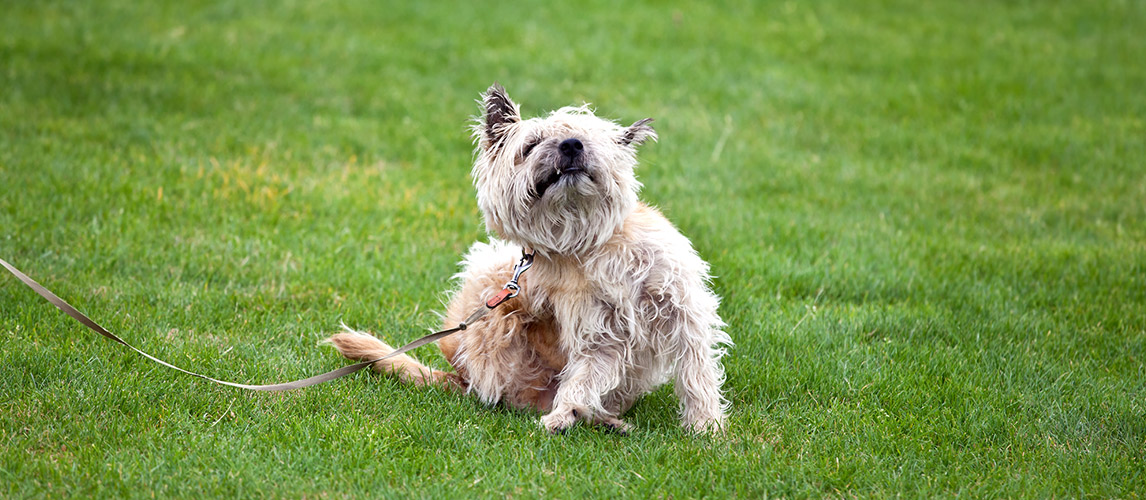Most dogs will experience allergic reactions at least once in their life. This could be due to food allergies, environmental allergens such as dust, or more often than you might think – seasonal allergies. A dog’s immune system is generally pretty robust, but certain breeds are known to be more sensitive than others. So if your dog’s skin is intermittently causing problems and you’ve exhausted all other options, you might want to consider the possibility of seasonal allergies being the culprit. Seasonal allergies in dogs can be extremely frustrating, but once you’ve got it figured out you can save your put a lot of stress and discomfort.
What Are Seasonal Allergies?
All allergies are caused by the immune system responding far too aggressively to a particular trigger (or several triggers). A season allergy is usually triggered by an environmental factor that comes with the change of season. The most common triggers are pollen and grass, much like hayfever in humans. This can result in allergic dermatitis when your dog comes into contact with the triggering substance, which leads to itchy skin and inflammation.
How Long Do Seasonal Allergies Last For?
An allergic reaction caused by seasonal changes usually lasts throughout the season until the affecting substance has subsided – such as when the flowers lessen or die completely resulting in a significant reduction of pollen spores. You will also need to ensure you bathe your dog at the end of the season to release any allergen material that could be trapped in their fur.

Causes of Seasonal Allergic Reactions
As previously discussed, seasonal allergies occur at particular times of the year depending on the presence of certain allergens in the environment. Most typically it can be seen in the spring and summer months when flowers and weeds are most prevalent and the grass is being cut constantly. However, there are a few additional natural allergens that are seen during particular seasons that can trigger an allergic reaction:
Pollen & Weeds
Pollen, which is found in concentrated forms in all flowers is the most common cause of an allergic reaction. The difficulty with pollen is that it is easily transported and spread thanks to the hard work of bees, meaning it can be found pretty much anywhere during the spring and summer months. A good idea, if your dog struggles with pollen allergies, would be to avoid purchasing live flowers to have in the house. As beautiful as they are, they could exacerbate the symptoms.
Grass
Grass is regularly cut throughout the warmer months and is one of the most common causes of allergy symptoms in dogs owing not only to the volume of grass around them but also their unavoidable proximity to it. Especially in a grassy backyard.
Mold Spores and Fungi
More often a problem in the autumnal months, there are certain fungi and mold spores that can trigger the same allergic reaction as pollen. As moisture levels rise and the weather becomes wetter, these allergens are more likely to form and cause a flare-up.
The Symptoms of Seasonal Allergies
The main symptom of seasonal allergies that most pet parents notice off the bat is itchy or sensitive skin. However, there is a multitude of allergic reaction symptoms that come with season allergies such as:
Recurring Ear Infections
An acute allergic reaction to pollen or any seasonal allergens can be accompanied by recurring ear infections as excess pollen gets into the ears and causes excessive irritation. If the dog’s itching its ears in response to the irritation it can damage the skin, exposing it to bacteria that can lead to infection.
Skin Sensitivity & Itching
Skin irritation is easily one of the most common signs of an allergy and is typically responded to by your dog scratching and biting the bothersome area constantly. By scratching at their irritated skin excessively, your dog can develop secondary skin infections from exposure to bacteria, much like with ear infections. They can also strip the most severely affected areas of fur, leaving bald, raw, exposed areas of skin (usually around your dog’s paws and legs, as they can be easily reached and are more likely to be directly exposed to allergens and are therefore the most commonly affected areas).
Irritated Eyes
If spores or allergens get blown into your dog’s eyes it can cause them to become swollen, itchy, and generally irritated. The immune response is then to cause them to water which can only add to the frustration your dog is feeling, especially seeing as watery eyes hinder their ability to see clearly. Once again, your dog’s reaction to this common symptom can also lead to bacterial infections if they’re not careful, so watch closely for if your dog appears to be frequently rubbing its face against furniture.
Runny Nose & Incessant Sneezing
The body’s immediate response to an irritant getting up the nose is to cause it to run. This is the same with both humans and dogs. Bearing in mind that dogs have much more sensitive noses than humans and are more likely to sniff up something troublesome whilst out on a walk. This is the least problematic symptom, but can still lead to sinus infections and discomfort.
How To Check For Seasonal Allergies
There are a few ways to check whether or not your dog is struggling with seasonal allergies or different skin allergies that can look very similar:
Skin Testing or Blood Testing
It is possible to have allergy testing done by your veterinarian if you’re really struggling to understand the source of the allergy. Though it is likely your vet will want to explore other avenues before going as far as allergy testing, as this is an expensive way of whittling down the culprit and they will want to remove other common allergens from the list before pursuing the testing route.
Watch For a Pattern
Some dog owners simply notice that their pup only seems to struggle with these symptoms at certain times of the year, or once a year. If you’ve noticed a similar pattern, it may be worth testing out some of these allergy easing methods to see if they help the symptoms to subside.
Limit Their Allergen Exposure
If you try to keep the windows closed where possible, remove your shoes before walking into the home to prevent tracking pollen into the house, and try to walk your dog in less grassy areas where possible, this could be enough to reduce their symptoms. If you notice that your dog appears to be more comfortable with these changes, it could be an indicator of seasonal allergies.
Ways to Ease Seasonal Dog Allergies
There are several ways that you can ease your pet’s discomfort depending on the severity of their reaction. Some owners only need one or two of these methods, however, some may need to take a more drastic approach with veterinary intervention.
Topical Dog Shampoo
Frequent bathing your dog’s body can remove excess pollen or other allergens from your dog’s fur and help to reduce itching. Something absolutely worth having in stock for allergy season is soothing shampoo. A topical shampoo can help to reduce inflammation and irritation providing immediate relief for your furry friend.
Change Your Daily Walk Routine
Most dog owners are able to at least reduce the number of problems their dog is having by creating a change in their walk routine. By taking your pup to less flower and grass populated areas, you can significantly reduce their exposure to pollen. For the less-severe allergies, this can be enough to make a dog much more comfortable.
Fatty Acid Supplements
Omega fatty acids help to nourish a dog’s skin and keep its coat healthier. This additional level of care may help your dog’s skin to protect itself better against the effects of inflammation, soothe itchy skin and generally be less problematic during the difficult seasons.
Veterinary Medicine
If your dog’s symptoms don’t die down with the more holistic approaches, you may need to speak with your vet about medication to help ease the discomfort. This could be topical medicated creams or dog shampoo for the more irritated areas of skin, antibiotics for any infections that may occur – giving the immune system room to work against the infection and clear it.
Pet allergies can vary dramatically in severity, but if you’re ever worried that your dog doesn’t seem to be improving, don’t hesitate to contact your vet and have them looked at more closely.
Allergy Shots
The most severely affected dogs may require antihistamine shots to keep the reaction under control. However, this is very rarely needed and it is usually obvious when it’s needed. If your dog’s allergy symptoms seem to be getting worse as opposed to better, despite trying all other forms of soothing the problem, it would be worth contacting your veterinarian to enquire about a stronger form of treatment.

Other Dog Allergies With Similar Symptoms
These symptoms are not only confined to seasonal allergies, however. Itchy skin, in particular, is a major symptom of a variety of allergies in dogs all of which can often be identified by the accompanying symptoms to help you whittle down the possibilities and potentially prevent the need for allergy testing.
Flea Bite Allergies
Flea allergy dermatitis can look a lot like season allergies, however, this can be easily identified by checking your dog over for fleas. If you see that there are fleas present you should try using a flea treatment to kill them off and then use a skin-soothing bath wash and flea comb to remove and eggs left behind. Flea allergies are caused by a reaction of flea saliva from flea bites as opposed to an allergy to the thing itself. As a result, strict flea control is essential to avoid a reaction.
Food Allergies
A food allergy can also trigger irritated skin and can be caused by a wide range of ingredients from wheat and gluten or fish oil to certain proteins. However, there are other food allergy symptoms that often accompany skin problems. These allergy symptoms can be helped by switching your dog’s diet to a hypoallergenic diet to reduce the number of problematic ingredients they’re consuming.
Environmental Allergies
There is usually something in the environment causing this type of allergy which can look identical to season allergies. However, the difference here is that if the problem is within the house the allergic reaction will persist year-round. Dust mites are a common cause of inflamed skin, though it is also possible that your dog could be reacting to cleaning agents, air fresheners, or even furniture fabric.
Understanding the causes, and symptoms of an allergy can make it much easier to handle. especially if you’re unafraid to seek professional advice when necessary. Simply watch out for the signs and begin a gradual process of elimination to help you better understand the specific cause of your dog’s discomfort. You can begin helping them in whatever way works best for you and your pup – make those difficult months significantly easier for your canine companion.
Source:
- Does Your Pet Have Seasonal Allergies?, Michelson Found Animals
- Signs of Seasonal Pet Allergies, Dowe Lewis







